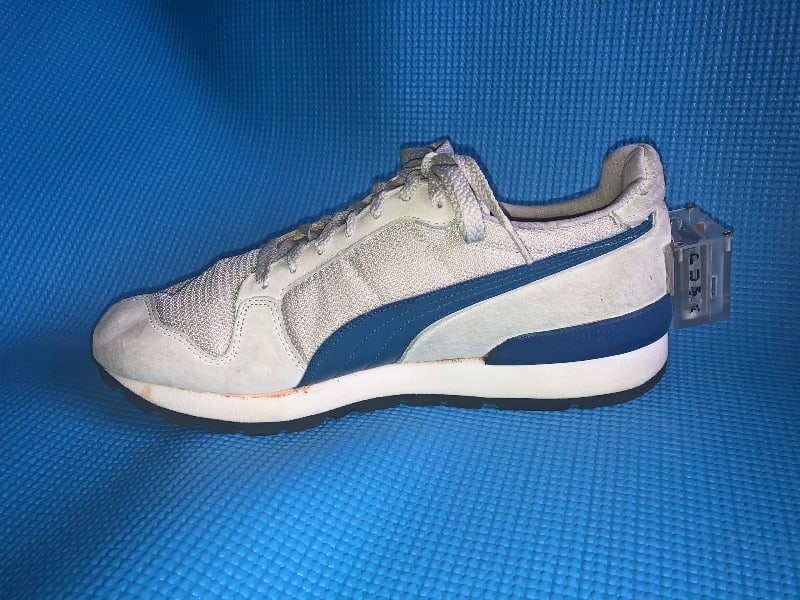In the 1980s, Puma owner Armin Dassler approached his sports science advisor Dr. Peter Cavanagh with the task of creating something that would make his sneaker company a technology leader.
Dr. Cavanagh’s idea: Turn the shoe into a computer.
Cavanagh created the RS Computer running shoe – a sneaker with a computer chip built into its chunky heel module. Runners could connect the shoe via a 16-pin connector to an Apple IIE, Commodore 64, or IBM PC to receive data related to distance, time, and calories.
How it worked:
When you started your run, you would press a button on the shoe to initiate sampling. After you completed your run, you’d press the button again, ending the data-gathering phase.
Then, you could plug your shoe into your personal computer, and the data would be uploaded via a serial port.
For a shoe that incorporated cutting-edge transistors and electronics, however, the critics weren't so keen on the new idea, according to Cavanagh.

“Running Magazine said, ‘No person, however rich, should ever pay a hundred dollars for a pair of running shoes,’” Cavanagh told Tech Briefs.
But times have changed. Although computer shoes never quite caught on, today most of us won’t go out to exercise without some form of activity tracker – even if the tracker isn't in the shoe itself.
In late 2018, Puma reissued the RS Computer Shoe – an affirmation, says Dr. Cavanaugh, for an idea whose time had not arrived quite yet.
The limited re-release has new technology, but replicates the original "RS" experience. A connector cable is no longer used to connect to a computer, but instead charges the shoe via a USB connector. The sneaker is fitted with Bluetooth technology to connect to an Android or iOS smartphone and a dedicated RS Computer Shoe app to manage and process all the information. (The app interface even uses 8-bit graphics seen on original computer screens.)
Dr. Cavanagh spoke with Tech Briefs to look back on the early days of the RS Computer shoe – and to look ahead to how he imagines the future of wearable technology.
Tech Briefs: Tell us a bit about your background. How did your background set you up to create the RS Computer shoe?
Dr. Cavanagh: I have had a long career in academics. I've been a professor at Penn State University. I have been a department chair at the Cleveland Clinic in Ohio, and a member of the faculty of the University of Washington Department of Orthopedics. My abiding interest has been in the mechanics of locomotion, walking and running, and that has been informed by my own history as a runner.
I was kind of a so-so marathon runner. During my time running marathons, I was also doing a lot of experiments on running and running shoes, footwear for running, so that's what led to my work with Puma where I served as advisor on sports science for Puma during the 1980s and early 1990s, and it's at that time that I started developing the computer shoe for Puma.
Tech Briefs: What did the shoe look like?
Dr. Peter Cavanagh: The RS-Computer, depending on your point of view, either looked like a running shoe with an ugly bump on the back, or it looked like a fairly futuristic device where a streamlined enclosure was built into the heel of the shoe projected backwards. There was one on the right side and the left side, but only the right side contained active electronics.
There was an electronics module with a press-to-touch switch, and a small LED as a user interface. There was also a flap which you could connect a serial cable. This was in the days before USB, and so a conventional small serial cable was inserted into the shoe after the run had finished.
Tech Briefs: How did the idea come about?
Dr. Peter Cavanagh: At the time I was working as sport science advisor to Puma, and Armin Dassler, who was a legendary owner of Puma, wanted to do something different, and he challenged me to do something that would put Puma out front technologically. He didn't care what it was. He didn't care how much it cost. He just told me he wanted me to bring in something that would identify Puma as a leader in technology, and so that's what we did,
Tech Briefs: How did it work exactly?
Dr. Peter Cavanagh: I had the notion that if you knew something about the way the wearer was running, then you could do much more than predict step count. You could actually predict running distance. This was also before it was feasible to incorporate GPS into the device, so it was a matter of using the characteristics of the user’s running style to predict distance.
What would happen is that when the person first got the shoe, they would do a brief calibration run. They would go on a 400-meter track, or a 440-yard track, and they would do a couple of laps, and they would count the number of strides they had at a given speed. Then, they would increase the speed, and increase the speed, and put that data into an app that we provided.
Now, in those days, it wasn't a matter of downloading the app from the Internet. The app was actually provided on a five-and-a quarter inch floppy disc. So you'd run the app. It had the kind of features you see in today's activity trackers. It would let you track your runs, and how far you'd run. You could enter comments. It would give you graphs of your history over the last week, the last month, the least year. So all of the sort of features you now depend on in an activity tracker and its accompanying app were there in this device.
Tech Briefs: And then you’d plug your shoe into the Commodore 64?
Dr. Peter Cavanagh: There was no readily available Bluetooth connection then so when you started to run, you would press the button to initiate sampling. When you finished, you would press the button again. Then, at any time later, you would plug the shoe into your personal computer, and the data would be uploaded via a serial port.
Tech Briefs: What were the early prototypes like?
Dr. Peter Cavanagh: I worked hand-in-hand with a microcomputer engineer at the University of Erlangen in Germany. Microelectronics were not really well developed at the time we were building this, and he built a special device called a gait array, which was basically a matrix of transistors which, although revolutionary at the time, is laughably uncomplex in retrospect. There are billions of transistors in an iPhone, and I think there was something like a thousand transistors in this gait array. But, nevertheless, it was state-of-the-art at the time, and it allowed us to conduct the functions of the shoe and to store the data in a relatively primitive store of flash memory.
The first prototype was simply a plexiglass rectangular box that we attached to the back of the conventional shoe. In fact, I still have that prototype. It was transparent and you could see the electronics, but it was proof of concept and enabled us to show that this technique would actually work.
Tech Briefs: What were the early reviews of the shoe?
Dr. Peter Cavanagh: It was not well received at the time. People really derided the whole notion of wearables at the time. We introduced the shoe in the spring of 1985 with a launch at the Athletic Club in New York City.
We had a runner on the treadmill. We demonstrated how it worked, we connected the shoe, and showed what you could download. The Washington Post, for example, said that I was peppering my remarks with computer-ese with words like "interfacing compatibility" and "user friendliness," which really were objects of derision, at the time. Sports Illustrated said that there was a "bulge," which was the shoe's "crowning feature," and that I was a 2:45 marathoner with a Monkish aspect .
Running Magazine said no person, however rich, should ever pay a hundred dollars for a pair of running shoes.
Tech Briefs: Given that the early reviews weren’t great, how does it make you feel that Puma is reissuing the shoe?
Dr. Peter Cavanagh: It’s a nice affirmation that it was a good idea whose time had not yet come. I like what Puma have done. It's a very nostalgic sort of thing. It is, of course, a limited-edition reissue, but I think it does just put a marker down and say that this was something we were doing back in the 1984-to-1986 kind of time frame, and that it really is something that people have come to value. Most of us will not go out to exercise any more without some form of activity tracker. I know I won't. I think that it was an idea that was ahead of its time during that era.
Tech Briefs: Do you have a sense of where you think wearables are headed in the future?
Dr. Peter Cavanagh: I think they will become more unobtrusive, and I think things like the Apple Watch are part of that. I have an Apple Watch and I love the way it just wakes up and says, "Oh, you appear to be doing an indoor treadmill run. Shall we record it?" And off it goes. I think that it's not so intentional any more.
With our computer shoe in the '80s, you had to be very intentional about it. You had to calibrate it. You had to turn it on. You had to turn it off. You had to upload it, and so what's happened is it's become very much a part of life that does not need much effort on the part of the user, and I think that will continue as we see more elaborate exercise devices in the future.
What do you think of the RS Computer Shoe? Write your comments and questions below.


